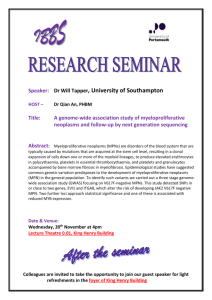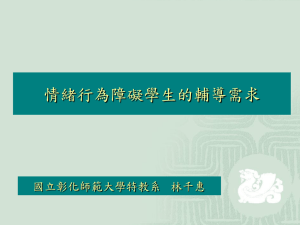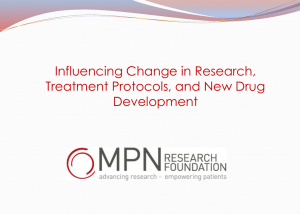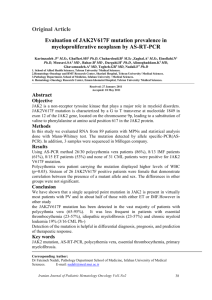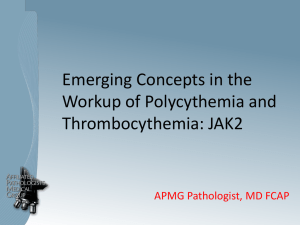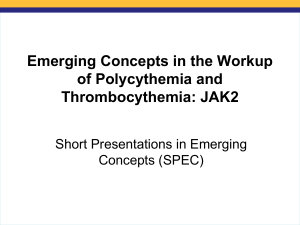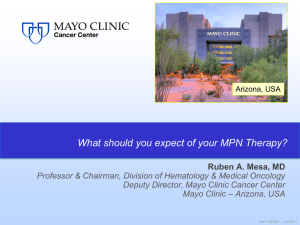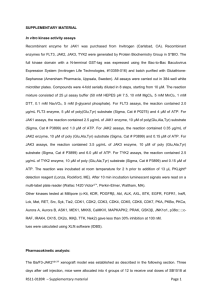2013 MPN Patient Education Conference
advertisement
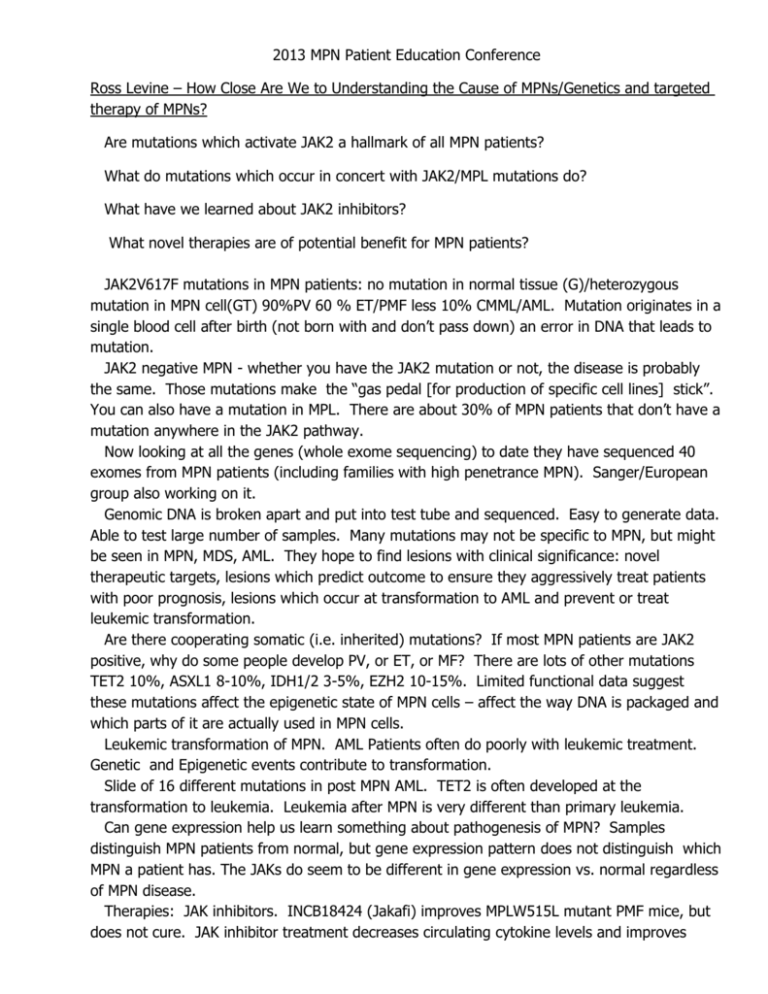
2013 MPN Patient Education Conference Ross Levine – How Close Are We to Understanding the Cause of MPNs/Genetics and targeted therapy of MPNs? Are mutations which activate JAK2 a hallmark of all MPN patients? What do mutations which occur in concert with JAK2/MPL mutations do? What have we learned about JAK2 inhibitors? What novel therapies are of potential benefit for MPN patients? JAK2V617F mutations in MPN patients: no mutation in normal tissue (G)/heterozygous mutation in MPN cell(GT) 90%PV 60 % ET/PMF less 10% CMML/AML. Mutation originates in a single blood cell after birth (not born with and don’t pass down) an error in DNA that leads to mutation. JAK2 negative MPN - whether you have the JAK2 mutation or not, the disease is probably the same. Those mutations make the “gas pedal [for production of specific cell lines] stick”. You can also have a mutation in MPL. There are about 30% of MPN patients that don’t have a mutation anywhere in the JAK2 pathway. Now looking at all the genes (whole exome sequencing) to date they have sequenced 40 exomes from MPN patients (including families with high penetrance MPN). Sanger/European group also working on it. Genomic DNA is broken apart and put into test tube and sequenced. Easy to generate data. Able to test large number of samples. Many mutations may not be specific to MPN, but might be seen in MPN, MDS, AML. They hope to find lesions with clinical significance: novel therapeutic targets, lesions which predict outcome to ensure they aggressively treat patients with poor prognosis, lesions which occur at transformation to AML and prevent or treat leukemic transformation. Are there cooperating somatic (i.e. inherited) mutations? If most MPN patients are JAK2 positive, why do some people develop PV, or ET, or MF? There are lots of other mutations TET2 10%, ASXL1 8-10%, IDH1/2 3-5%, EZH2 10-15%. Limited functional data suggest these mutations affect the epigenetic state of MPN cells – affect the way DNA is packaged and which parts of it are actually used in MPN cells. Leukemic transformation of MPN. AML Patients often do poorly with leukemic treatment. Genetic and Epigenetic events contribute to transformation. Slide of 16 different mutations in post MPN AML. TET2 is often developed at the transformation to leukemia. Leukemia after MPN is very different than primary leukemia. Can gene expression help us learn something about pathogenesis of MPN? Samples distinguish MPN patients from normal, but gene expression pattern does not distinguish which MPN a patient has. The JAKs do seem to be different in gene expression vs. normal regardless of MPN disease. Therapies: JAK inhibitors. INCB18424 (Jakafi) improves MPLW515L mutant PMF mice, but does not cure. JAK inhibitor treatment decreases circulating cytokine levels and improves body weight, reduces inflammatory state. Want to improve so medication removes the disease. Even with treatmenthe cells still have the ability to hang around. Scientists study cells exposed to different drugs and are trying to completely destroy the JAK mutant cells. JAK inhibitor persistent cells are insensitive to all the different JAK inhibitors. JAK2 becomes reactivated. Persistent cells are JAK2 dependent. Need better approaches to target JAK2. PU-H71 (and HSP-90 inhibitor) depletes JAK2 in leukemic, but not normal hematopoietic cells. (AUY922, PUH71 are being tested at MSKCC). With HSP-90 inhibitors we have been able to completely shut off JAK2 in mice and are now doing trials with patients. Summary: combination of meds like JAK2 inhibitors and PU-H71 can be very effective to shut off JAK2. Questions for Dr. Levine: If you under-dose does it increase the strength of the disease vs. using maximal doses? Yes, we need to use more maximal dose and test how much and how often dose should be administered. Is there any evidence of PV % converted to MF? A few % every few years. Are there predictors? They are researching on who will convert to MF and is his major goal for this year. Dr. Silver asked about patients that are not responding to one JAK inhibitor may they respond to another JAK inhibitor? Yes. In mice if you take the drug away for a few weeks after it fails due to persistence and it can work again after the break. Are there trials with JAK inhibitor/delineation therapy? Not yet, but hoping to work on that. Dr. Reuben Mesa & Dr. John Camoriano – Prognostication & Management of MPNs: 2013 Update Dr. Mesa was “introduced to MF” by Dr. Tefferi. Dr Tefferi was unable to attend because of jury duty. MPNs (ET, PV and MF) history. William Dameshek in 1951 felt these diseases were related. Incidence per 100,000 is: CML 1.6, ET 2.3, PV 2.2, PMF 1.0 (all per year.) Natural history of MPNs: MPN because of symptoms (blood clot or event) (typically >10 yrs) or those with PMF or post ET/PV MF (variable, 3-5 yrs common) Patterns of survival – many with ET and PV can live normal span. In the past that was not necessarily the case. ET vs early MF. ET normocellular, dispersed large to giant megakaryocytes. Early PMF hypercellular, prominent clustering of abnormal megakaryocytes, hypolobulated/hyperchromatic nuclei, granulocytic proliferation. Cumulative incidence of MF. 15% of ET were actually early MF. Post ET/PV Myelofibrosis. There is not one thing you can point to, it is a spectrum that can take several years. The overproduction of cells quietens down. Features of post MPD MF: Anemia, worsening counts on HU, increasing splenomegaly, developing constitutional symptoms, increasing bone marrow fibrosis. Risks: blood clot, conversion to MF, death. Some things that have relevance – white count, (high or low); platelets too few sign of progressive, too many can be problematic; JAK2 level may not have major impact but ET with JAK2 may have more risk of blood clots. Slide “Evolving MPN prognostic scales” for ET PV and PMF. Almost all therapy for ET for reduction of thrombosis & bleeding. All should receive aspirin unless contraindicated. Aggressive control of CV risk factors. Cytroreduction with high risk (HU, AG, IN in order of preference) For PV not MF conversion or blast phase. Management PV maintain HCT <45% men, 42% women. Low dose ASA. Management of MF: villain is not fibrosis, anemia, symptoms or spleen enlargement , it’s the clonal MPN cells. Therapy choices: transplant, medical therapy and JAK2 inhibitors, or observation. Transplant decision: age, donor, disease status, etc. Medicines for MF anemia: androgens, EPO, thalidomide. Meds for spleen, HU, busulfan, 2-CDA, splenectomy, splenic radiation. Before deciding therapy, important to consider: patient goals & input, improving symptom burden, balancing spleen/cytoses, extending life. Dr. Camoriano Case 1 – ET 2008, age 67 with 14 yr history of platelets above normal; no symptoms, parents both died in late 80s of natural causes; very active and never smokes, platelets were 1.675 million and potassium 6.1. Lifestyle has a big impact on vascular risks. Not everyone needs therapy. Case 3 – post PVMF 1994 prostatectomy Hct 52, platelets 500,000. 6/2009 immature white cells including blasts, BMB 6/09 reticulin 3, splenomegaly while on aransep & AG. Spleen improved but anemia got worse. Was converting to MF, but blasts declined to 0 with aranesp, pegasys. Multiple therapies may be the future of MF therapy and is sometimes helpful now. Dr. Alessandro Vannucchi – Evolving treatment for ET They had a patient conference in Italy. ET is one of the “classical” forms of MPNs. This year has been important for research in MPN. These diseases are so different from other cancers. ET is probably the most common MPN. Large proportion of young subjects. Main feature thrombocytosis. Main clinical manifestations are vascular. Evolution is most uneventful among MPN, usually late transformation to PET-MF in <10%, leukemia in <5%. Many don’t need therapy for many years. WHO criteria for diagnosis of ET requires all four criteria: 1. Sustained platelet count > 450. 2. BMB showing proliferation mainly of megakaryocytic lineage… 3. Not meeting WHO criteria for PV, MF, etc. 4. Demonstration of JAK2 or other clonal marker. BMB essential for diagnosis of ET. Pre-MF: hypercellular, > granulopoiesis, , < erythropoiesis, dense or loose clustering of med/lg size megakaryocytes with irregular nuclei, not significant increase in reticulin fibers True ET may evolve to MF. There is a increase in fibrosis, anemia, leukoerythroblastic peripheral blood, increase in spleen, development of symptoms. Prognosis in ET. Risk classification according to risk of thrombosis and bleeding, conversion to MF, or death. >60 or history of thrombosis are high risk, cardiovascular risk factors are intermediate risk. What you can do: improve your personal environment; being active, not smoking. Viability of treatment determined by age and risk of thrombosis. HU has been shown to prevent thrombosis in high-risk ET, did better in study compared to AG in preventing arterial thrombosis in high-risk ET. No substantiated evidence of increased leukemogenicity of HU. HU is usually well tolerated for long periods. Other drugs AG or IN. AG targets only platelet counts; usually well tolerated, modest cardiac side effects, may reduce Hg in some. INF can induce molecular remissions (more in ET than PV), poor tolerance, pegylated forms may be be better tolerated. New study of AG vs HU a month ago in Europe. No evidence of inferiority of AG vs HU. 259 true ET patients. Similar rate of hemorrhages or discontinuation. Ongoing trials with INF. New drug Vorinostat inhibits enzymes (histone deacetylases) that regulate the transcription of genes in proteins. Response in 35%. No effect on JAK2, high discontinuation rate 52%. Drug Imelestat is the first specific telomerase inhibitor. Hematologic response in 100%, decreased JAK2, has side effects of infections, anemia, neutropenia. JAK2 inhibitors INCB 18424 (ruxolitinib, e.g. Jakafi) can reduce the platelet count and has been well tolerated. 90% overall response, reduction of spleen, normalized leukocyte count, but not changes in JAK2. Dr. Srdan Verstovsek – JAK2 inhibitors: Where do we stand? Main clinical problems of MF: anemia, splenomegaly, hepatomegaly. No current medications work too well for too long. Slides of JAK-STAT signaling. About 20 other mutations have been discovered. JAK2 is not a cause for the disease, just a contributor. JAKSTAT pathway dysregulation, regardless of JAK2 mutation, is key pathologic feature of MPNs. In JAK2 inhibitors an expected side effect includes lowering platelets and red blood cells. Elimination of disease unlikely. Benefits patients without JAK2 mutation. 10 different JAK2 inhibitors being developed. Efficacy judged by splenomegaly, quality of life, anemia. JAK inhibitors usually shrink the spleen significantly within 2-3 months and then is sustained for a long period of time (more than 2 years). Doesn’t usually reduce spleen to normal, but significant reduction in size (some up to 80%) most have about 35%. Those with >10% reduction have great reduction in symptoms with improved quality of life. Ruxolitinib helped a lot with symptoms of fatigue, insomnia, appetite loss, dyspnea. Rapid reduction of symptoms. No significant improvement in hemoglobin. Bone marrow fibrosis does not change. If therapy is stopped return of symptoms within 7 days. It is better to reduce the dose if counts go low rather than to stop the therapy. Patients do not get worse, but return to pre treatment level. JAK2 inhibitors prolong life on MF? Goals: increase benefits seen with JAK2 inhibitors, reduce unwanted side effects, reduce JAK count. There are or will be several studies with Ruxolitinib in combo with other drugs. Treatment helps improve patients to the point where they can have a transplant. Dr. Richard Silver – Curability of PV with Interferon Hosting NY patient conference Nov. 6. Talked about brief history of treatment of PV, types of IFNs, clinical & molecular results, conclusion. PV trials 1967-87 with P32, Phlebotomy, Chlorambucil. Phlebotomy did best, Chlorambucil did worst. Another study showed phlebotomy only had poor clinical tolerance, frequency of vascular complications in the first 3 years, (but note: only phlebotomized to HCT 50%), risk of early progression to MF. Worldwide the preferred treatment is HU but failure rate is pretty high. His choice is IFN. IFN discovered more than 50 years ago, they are proteins. INF Type 1, 2 or 3, Type 1 for MPNs. Two types of pegylated IFN, Peg-IFN a-2b and Peg-INF a-2a (Pegasys) has a more stable amide bond; longer half life; prolonged plasma concentration; maybe prolonged efficacy. These drugs were developed for Hep C, but no randomized controlled trials, similar results in one CML comparative trial, safety similar. IFN specifically affects JAK2 in mice. Affects intracellular signaling related to JAK-STAT, inhibits early red cell & megakaryocyte development, inhibits blood vessel formation. Start and maintain low dose. All 55 patients have had clinical responses. No thrombohemorrhagic episodes (for as long as 20 years). Molecular changes with PEG-IFN. Decrease in JAK2 (90%), reversal of chromosome abnormalities, restoration of polyclonal hematopoiesis, normalization of PRV-1 expression, suppression of endogeneous erythroid colony growth. PV has broad clinical manifestations. Those with high phlebotomy vs. low phlebotomy requirements. Interferon is effective in treating the fibrosis that occurs in PV. TET2 persists despite eradication of JAK2. JAK2 cells in some EPO-independent colonies, If evolve to AML lost JAK2. More mutations seen in poor response to IFN. Conclusion: interferon may be the best treatment for proliferative aspects of PV. Need a controlled clinical trial. IFN in combo with JAK2 inhibitors and other drugs. Can’t use IFN for hematocrit control, need to use phlebotomy. PV is not curable with IFN, but don’t despair-inducing clinical remission is possible & attainable. Quality of life can improve. Doctor Panel Question and Answer Session Does niacin reduce platelets? I’m not aware of such an effect. Dr. Mesa’s prognostic slides – most use a range of 55 and older. Are there prognostic scores for younger patients? Not all factors of an individual’s health go back as far as 10 years. The average age for MPNs is mid 60s, so that is more median. Does the presence or absence of Philadelphia chromosome have relevance to MPNs? CML is one of the 4 MPNs. Gleevec had amazing results with CML. Can you convert from ET to PV? Vannucchi: Yes, particularly with JAK 2 If therapy helps with the white count will that help with the clinical progression? Vannucchi: Do not yet have clear trials When to start JAK2 in MF? Verstovsek: Intermediate or high risk of disease. Not for low risk. If they have symptoms of enlarged spleen, anemia, are older. When the spleen enlarges what is growing & to the degree the spleen takes over for the bone marrow what are the effects of removing the spleen? Pardanani: there are elements of the bone marrow cells that plant themselves in the spleen. Spleen is not optimized for that function for it is not effective. Splenectomy if spleen is large and patient very symptomatic not reason for taking it out. If you take Pegasys can you still have a SCT? Deeg: Are there medications that impair chance for SCT? We have not been able to identify any adverse effect of transplant because of medications. How often should BMB be done? Mesa: What we learn from BMB: 1. Any fibrosis increase or decrease 2. Chromosomes – impact of genetics 3. Blasts. Some BMB for diagnosis or baseline. Repeat to try to see if therapy has improved disease or evidence of progression (time to consider transplant). (He recommended to patient this week getting a repeat every 2-4 years.) Camoriano: trials often require them much more often. Silver: critically important for diagnosis. How does someone with PV know if they have the TET2 mutation? Gotlib: For practical purposes in 2013 the JAK mutation is more common. TET2 is one of several other mutations found in MPNs used more in research labs. We use them less to gauge prognosis, more for diagnosis. Probably in future years there will be a panel of tests. Pardanani: If you have a good BMB at diagnosis you probably don’t need to make the effort to test lots of mutations. The role of mutations is probably more important in MF than PV or ET. Are there drugs we know to be safe with Ruxolitinib? Verstovsek: Germany did one with erythropoietin and had good results. He uses Danazol in combination. Most combos are in trial and too early to judge. Mesa: MF in a small set of patients have high platelet or white counts and HU or Pegasys was used with Ruxolitinib for them. HU and Pegasys used to lower counts. The more combo trials we can do the more helpful it will be. Pardanani: Ruxolitinib was the first in class of the JAK2 inhibitors. The next generation drugs are usually better. Non drug therapies? Camoriano: G6 was very active in mice. We don’t have any such recommendations. Utilization of diet in the improvement of health. “The China Study” book on anti inflammatory diet. “The Mediterranean Diet”. Both books recommended as therapeutic arm to lower white cell counts, and improve risk of vascular events. When will Pegasys be approved for PV? Mesa: Before a drug is approved it has to be used in a clinical trial in the US. Once it is approved a doctor can prescribe that drug for anything they want. They are liable, but they can use it. Coverage by insurance becomes an issue without FDA approval. Pegasys is approved for Hepatitis C. If we try to use Pegasys for PV the insurance decides if they will pay for it. You can appeal, but the insurance decides. In order for a company to get formal approval from the FDA for a medicine for a different condition is very expensive. If the studies show effectiveness then it is more likely for insurance to approve even though not FDA approved. We now have drugs that are initially for MPNs that are getting approval from FDA. Silver: Nationally 50-60 % of drugs are used off label. Dose side effects? Silver: yes, the dose of IFN is correlated to side effects, especially depression, or autoimmunity like arthritis. Dr. Joachim Deeg – Hematopoietic Cell Transplantation for MF Will include PMF and post PV or ET MF. Why transplant? How safe and effective? It should be possible to cure MPNs by replacing the patient’s stem cells. DIPSS risk factor classification developed for non-transplanted patients. Not included: marrow fibrosis (non-relapse mortality), other organ fibrosis, spleen size (delayed engraftment; difficult transfusion), duration of disease (co-morbidity), mutations. Transplant characteristics: HLA typing. Related and unrelated donor are equally successful. Non-relapse mortality higher in high risk category and lowest in low risk category. Survival after transplantation very good and long sustaining for low risk (20+ years). High risk group only 12 years. Main causes of death: relapse (18%), GVHD (25%), infection (24%), multiorgan failure (18%), graft failure/rejection (11%), secondary cancer (3%), intracranial hemorrhage (1%). Overall survival has improved since 2003. Survival with transplant higher than without in all risk categories. Survival times correlates to risk category. JAK2 positive survival not as high as no mutation, but not significant. GVT effect. Two best CY + BU, FLU + BU. Success of BMT related to dose of GVT. MF patients do better with CY prior than BU rather than reverse. Age related to survival. <55 years better than >55. His oldest patient to survive well was 78. Problems: GVHD, organ toxicity, relapse. If donor cells are treated with statins GVHD is lower. HCT offers effective, curative therapy for patient with MF. Safety has improved. Appropriate for most patients with advanced disease. Dr. Ruben Mesa – What Should We Expect from our MPN Therapies? What is the spectrum of disease burden and risk in MPNs? ET patients in purest form have lowest risk of transforming to MF. PV patient and Pre-fibrotic Primary Myelofibrosis may convert to MF after a long period of time. Burden of ET/PV microvascular symptoms and risk, MPN symptoms. Burden of MF splenomegaly, anemia/cytopenias, MPN symptoms. Normal red cell in MF is uncommon. 1/4 need transfusions. Anemia is the biggest issue. Fatigue has a relationship to anemia but comes directly from the illness. 89% of MF have splenomegaly. The spleen doesn’t affect progression but is uncomfortable, painful, possible infarcts, early satiety… Risk of blood clots and bleeding higher in ET and PV. Most common MPN patients symptoms: fatigue, pruritis, night sweats, bone pain, weight loss. Assessing symptoms done with surveys in various languages. MF patients are the most symptomatic with the exception of PV patients and itching. MPNs putting more proteins into the blood that could be causing symptoms. ET and PV symptoms fall in 5 groups clustered by percentage of symptoms. MF in 4 groups. Prognostic score is not correlated to burden of illness. Low risk can be very symptomatic and high risk can be unsymptomatic. Quality of life is hard to quantify. Have to consider symptoms, medication toxicities, prior complications, stress of having MPN, financial stress, emotional stress, intrapersonal stress, comorbidities, hassle of medical care. When considering therapy what are we trying to achieve: relieve burden of MPN, delay progression, prolong life, cure. In general MF people felt better after treatment of Ruxolitinib, but not other therapies. Dr. Will Mayo “The spleen is an organ of contradiction and mystery: in health of relatively unimportant function, in disease a menace of grave import.” Majority of JAK inhibitors are helpful therapies for MF. Toxicity things to watch: hematological, gastrointestinal and neurological. We don’t know if JAK2 helps with confirmation, progression, etc. We want to understand how symptoms are affected with available therapies. Symptomatic burdens has a large spectrum in MPNs. Symptom clusters exist. Improvement in symptom burden is goal. Individual therapies. Dr. Susan Leclair – Common MPN Laboratory Questions Used to be: get a diagnosis, cry, go to church & temple, take the meds, do what the physician says Now a Days: get a diagnosis, cry, go online & search, go for the roots & berries, argue-ask “why” Physicians speak medicalese – not English. You have to learn medicalese and to tell the truth. Don’t say fine, not bad, I didn’t tell him because he didn’t ask. Tell the truth with the physician. Remember medicine is an art and so there are some things they can’t explain. Different countries use different systems of concentration and values. CBCs: WBC can bounce around within a +/-3.0 range, can double the neutrophils/granulocytes if fever/exercise/emotional stress, suppressed by lots of cardiac meds such as ACE inhibitors. Try to get your CBCs at the same time of day and circumstances so they will compare better. You have to have 3 or 4 increases in the same direction before you may respond to it. Two different ways to describe the different white blood cells: percentage or absolute. Percentage only 100 cells, makes great comments about quality, both an increase in one cell and decrease in another can look the same. Follow the granulocytes/neutrophils they are controlled by the same cell as the red cells. No immature forms should be seen although a once in a while an intermediate form (metamyelocyte) can be tolerated. Reference ranges tell us what 95% of the people in this area, using this equipment and these medical people doing the test. Hemoglobin. RBC no longer the standard test. Hemoglobin-concentration of oxygen carrying protein, can quantify the hemoglobin that has oxygen and the hemoglobins that do not (carboxyhemoglobin) or can not (carboxyhemoglobin), remains consistent regardless of cell size. Hemoglobin can vary with age, sex, and altitude. Hemoglobin issues in over production. Viscous (jello with a lot of fruit as opposed to clear jello). Over 15g in males and 14g in women can cause other symptoms. Day before phlebotomy drink plenty and ask for a larger needle. Hematocrit is calculated from the MCV (average red cell size). Multiply MCV by the RBC count and you get the hematocrit. If the RDW is increased the hemoglobin values can be off.. If you phlebotomize you can increase platelets. What to include on spreadsheet: Date, ref. interval & value for WBC, ANC, HGB, MCV, MCH, RDW, PLT. (could add uric acid and LDH). Chemistry values to watch: Uric acid – waste product of nuclear metabolism. The more cell activity, the greater the number of waste products that must be cleared by the kidney. Too much – gout, kidney damage, joint pain. Keep your diet consistent – high protein meals increase uric acid concentration. PV Break out session (Silver, Noel, Gotlib) Side effects of Pegasys? Dr. Mesa has had two patients in hospital from Pegasys side effects. Main problem is liver, inflamed lung or heart (autoimmune more aggressive). Would need to end therapy in such conditions. It helps shrink skin cancer. Flat red rash on limbs but didn’t need to go off therapy. Dr. Silver mentioned Pegasys is not FDA approved. Dr Mesa has never, with appeals, had a patient that was not able to get on Pegasys. Do you see interferon side effects great enough that they need to stop treatment and doing well enough they can stop treatment? Dr. Silver: Always start with a low dose because these are chronic diseases and people are on them for a long time. Making the decision to when to start interferon? Dr. Silver looks at phlebotomy frequency of 8 – 10 a year, high cholesterol, diabetes, etc. Interferon is much better than HU for these patients. Those on Interferon don’t convert to leukemia. Would you treat low risk patient that needs 2 – 4 phlebotomies a year under 60? Gotlib: No for low risk, maybe for intermediate risk. What should PV patients watch for to indicate conversion to MF? Spleen enlargement, counts are lower (except white can go up), less need for phlebotomies. LDH frequently rises. Chance for oral interferon? We are working on it. Treatment help with risk factor? Yes, but not necessarily over night. Had PV for 17 years spleen continues to enlarge. When should JAK inhibitor be considered? Dr. Gotlib: FDA approval is for MF. Inhibitors also in trial and good at reducing it in a quick time frame. Symptoms more important than spleen size in when to have JAK inhibitor. Dr. Silver: you should have a BMB and try interferon. The reason HU is used is to suppress the bone marrow. Interferon doesn’t work if MF is too progressed. Dr. Noel: There is diversity of opinions of when to start therapy in PV patients that are controlled with phlebotomy. Interferon may change the history of the disease, but not everyone agrees. Is iron too low at 8? Are there symptoms with other organs? Gotlib: doesn’t worry about iron levels. Noel: if patients get low are they symptomatic of iron deficiency. If you treat the iron deficiency you’ll need more phlebotomy. Silver: The only way to help with that is to use treatment so phlebotomy need is decreased. Cognitive ability improves if low iron levels are improved. Dr. lets patients hematocrit go to 48-50. Gotlib: If hematocrit is 48-50 that is too high. Argue with your doctor if he disagrees. Is it standard of care for new MPN to be started on IFN vs. HU? Noel: PV usually with phlebotomy and aspirin. For older reasonable with HU and aspirin. Treatment with IFN is a very debated issue. Interferon first line treatment for children and women who are pregnant. Is there a study planned between HU and IFN? Dr. Silver: Yes. When you give HU the cells become larger in size. IFN doesn’t increase cell size. What is the better value to monitor PV, use Hct or Hg? Gotlib: For phlebotomy sake we use Hct so I use Hct. Hct doesn’t measure red cell mass well. Silver: characteristic with PV that bone marrow is absent with iron. Red count best measure of when to have phlebotomy, not Hg. Low cholesterol for MPN? Gotlib: low cholesterol also low in other cancers. Silver: patients with large spleens have low cholesterol. Noel: as patients become more aware of their diseases they learn more about various treatments and can choose more what is better for that individual. If you’re below the age of 40 it’s probably best to treat with IFN. How long can you be on pegylated interferon? Dr. Silver: had patients on regular interferon for 25 years, pegylated interferon is same. JAK2 inhibitors for PV? Dr. Silver: yes, but it doesn’t change the biology of the disease. Noel: overall response rate 70% and 50% have response rate for spleen size. Gotlib: We don’t know if it will change natural history, but they are with MF more advanced patient. PV may be a more JAK2 driven disease. Another thing to think about is price. JAK2 inhibitors are much more expensive than phlebotomy and aspirin. The second drug is now in phase 3 trial for MF. Noel: patients with PV have frequent thrombosis. We don’t have a lot of data with JAK2 inhibitors and thrombosis. Some patients can be on a low dose of Pegasys and it lowers JAK2 effectively. Gotlib: We don’t know if lowering JAK2 improves the disease. What is the percentage of PV patients that convert to MF. Dr. Gotlib: 10 – 15% after 20 yrs. Silver: I think that’s what is in the literature, but he feels it’s an understatement. Active disease with increased counts (malignancy) naturally progresses to MF. Noel: Agrees with Silver. If you wait long enough it will transform to MF. Interferon may help. Do you advise patients with PV and Budd Chiari to have lower counts? Noel: Be sure Hct below 42. It depends how stable you are with your disease. If there is fluid overload you need to be more careful. Dr. Silver yes. Medicine is subjective and we can’t give absolute answers. Should patient with PV have selective surgery (foot surgery). Noel: Be sure they are on prolonged anti-coagulation therapy (35 days). Gotlib: Be sure surgeon and hematologist work together. Difference in effectiveness to Pegasys versus regular interferon? Dr. Silver: no difference. Best way to transfer from HU to Pegasys? Noel: HU has a short half life so you may want to continue it for a while with the Pegasys. Pruritis studies going on? Noel: yes. JAK2 inhibitors are helping with pruritis because they decrease the burdens of the mast cells. Family history of depression is IFN a good option? Noel: not a contraindication for IFN, especially with lower dose. In general. Dr. Silver what do you mean by eliminating JAK 2? What I think I said was eliminating against INF? JAK2 is not the monster in these diseases. Gotlib: we’re talking about those cells that have the mutation and let the normal cells be produced. What is the dose of interferon to eliminate JAK2? Don’t know. Dr. Animesh Pardanani – New Therapies for MPNs: Beyond JAK2 Inhibitors What’s new in MPNs? Chronic Myeloid Malignancies: myelodysplastic syndromes, myelodysplastic/myeloproliferative overlap, myeloproliferative neoplasms (CML, PV, ET, PMF, CNL, SM, CEL, MPN-U) What’s new in PV? Life expectancy (1500 people studied) not significantly different from general 10 yr-80%. Main risk thrombosis, med. risk myelofibrosis, low risk acute leukemia. Why treat? To decrease risk of thrombosis we treat with low dose aspirin and phlebotomy to keep hematocrit below 45%, HU for high risk. Study from 1978 showed there is a direct positive correlation between hematocrit and blood clots. If you decrease the hematocrit from the high normal range to the low normal range you decrease incidence of blood clots four fold. A recent Italian study on optimal hematocrit (below or above 45). The patients that had the low hematocrit had a four to five % fewer incidence of blood clots. Patients with PV might be best served by keeping their hematocrit below 45%. His practice tries to keep women’s hematocrit below 42%. PV patients that are resistant to HU he uses interferon and busulphan. Trial for PV patients resistant to HU vs. Ruxolitinib or best available therapy is currently being conducted. Another study of patients that switch from HU to Ruxolitinib because they had a lot of symptoms on HU to see if the symptoms get better on Ruxolitinib is currently being conducted. Treatment used for freedom of phlebotomy, symptoms and splenomegaly and freedom from thrombosis, myelofibrosis, acute leukemia. Is your treatment doing these things? If not, challenge your doctors. If asked to be in a trial make sure it can do some of these things. For PV it’s not critical to have a BMB according to WHO. It is very critical that ET patients have a BMB at diagnosis because there are several other diseases similar to it, including prefibrotic MF. Risk of ET developing leukemia very low (1% a year) or developing MF (5%). If your doctor makes an accurate diagnosis of ET then for the vast majority of the patients is quite good (Life expectancy etc.), however they may still have problems with symptoms of the disease. According to WHO significant risk factors for thrombosis in ET: > 60 y, cardiovascular risk, previous thrombosis, JAK2 mutation. High risk put on HU, low risk just aspirin. Imetelstat rapidly induces and maintains substantial hematologic and molecular responses in patients with ET who are refractory to HU and other drugs. Imetelstat shuts down the telomerase, therefore, seems to be an attractive approach for treat ET. Imetelstat is an IV treatment originally given weekly and gradually reduced to as far as 6 weeks. The trial showed all the patients had a decrease in platelet count. 14 of the 15 completely normalized platelet count. Many have been treated for 2 years. All the patients had a decrease in the JAK2 mutation. This is an interesting drug. Let’s keep our eyes and ears open. We need to be sure it is safe for the long haul. They are starting a trial of Imetelstat with MF patients. Conclusion two main points: important to concentrate on thrombosis risk in ET and Imetelstat needs to be studied more. Another trial of Pegylated interferon vs. HU. MF triad of misery: anemia, splenomegaly, cachexia constitutional 5x. Treatment options are unsatisfactory. 15% transplant the others don’t have good options. JAK2 inhibitors are now first generation, hopefully with time they will be even better. So far the JAK inhibitors have significant improvement in splenomegaly and disease-symptoms, and may increase survival. They can reduce blood counts too low and develop need for blood transfusion. They are probably not modifying the course of the disease. Studies with combination of Ruxolitinib and other drugs are ongoing. If Ruxolitinib should you opt for another trial of another drug or a combo therapy trial? It’s not clear. Anemia has a prognostic impact on survival. Thalidomide, Lenalidomide, Pomalidomide (3rd generation and shows good potential). Just completed and stage 3 study of Pomalidomide and will be reported Dec. 2013. Dr. Jason Gotlib – Is my MPN inherited? Did I get it from my parents or will I give it to my children? CAD/MI(heart disease): acquired gene mutations, family history/genetic predisposition, hypertension, hyperlipidemia, diabetes, smoking, other. Family history – are there gene variations you inherited that can contribute to CAD/MI? Alzheimer’s disease: acquired gene mutations, family history/genetic predisposition, head injury, nicotine, hyperlipidemia, other. There are genes that cause familial early-onset alzheimer’s and some genes that make you susceptible to alzheimers. MPN: acquired gene mutations, inherited genetic predisposition, environmental factors, other. The acquired gene mutations: JAK2, MPL, BCR-ABL, KIT D816V, Exon 12 JAK2. Other acquired mutations TET2, AXL1, DNMT3A, CBL, LNK, IDH ½, … Acquired mutations are on various chromosomes among the 3 billion letters that make up the full DNA code. Inherited genetic predisposition: Swedish registry data showed the risk of MPN JAK2 positive is 5% if several relatives have MPN. An inherited area of JAK2 gene that is not the acquired mutation. There is an inherited JAK2 mutation that is in a different area of the JAK2. Almost a 9 fold risk if two inherited JAKs, 3 fold risk if one inherited. 46/1 JAK2 haplotype is inherited mutation. Two hypotheses for MPN development: hypermutablility or fertile ground. There is no association between 46/1 and either clinical features and outcome, so there is currently not a role for screening for 46/1. Average MPN incidence rate 2/100,000, with 46/1 3-4% higher. Some very very rare inherited mutation with JAK2 V617I where very high platelet count. 23andMe doing MPN research. Collected 1000 saliva samples for genotyping. Showed JAK2 and TERT mutation showed increase in getting MPN. One TERT mutation increases risk 1.7x. Two TERT mutations increases risk 2.7x. TERT is a component of telomerase, a protein that modifies the ends of chromosome to maintain their stability (which stops the mechanism that limits the ability of cells to divide forever). How did I get this disease? Perhaps an inherited genetic predisposition, an acquired gene mutation, or environmental factors? The acquired mutation was found in study patients in control group as well as MPN patients. Pierre Noel – Thrombosis and bleeding In medicine things which make a lot of sense are not necessarily correct. The accepted practice 10 years ago for patients ended in giving them leukemia. Scope of problems: thrombosis (PV especially), bleeding (ET especially). The higher the platelet count the higher the risk of thrombosis or bleeding. Increase white cell count, inflammation, JAK2 mutation, tends to increase risk. Why do we bleed? Decreased platelet granules, abnormal aggregation of platelets, increase breakdown of Von Willebrand molecule by ADAMTS13 related to platelet count. Disagreement in standard of care: Tefferi – HU, Silver – Alpha-IFN. Clotting issues: Balancing the risk of thrombosis vs. risk of bleeding. Aspirin for primary prevention (primary prevention means you haven’t had a stroke, heart attack or other major clot). Patients taking aspirin have higher risk of GI bleeding. Aspirin impacts thromboxane production which is associated with MPNs, Plavix is not. Plavix is associated with a risk of bleeding. Take Aspirin with food and consider proton pump inhibitor. Risk of bleeding is 3X increased with >200 mg/day aspirin. Secondary prevention (had a TIA, stroke, etc.) and want to prevent another. No specific data for MPN patients In non-MPN combo of ASA and extended release dipyridamole was helpful. If you have a TIA while taking ASA and HU you may consider adding Plavix. If you have a TIA while taking ASA you may consider cytoreductive therapy or Plavix. If you have the AF while on phlebotomies, ASA and HU, consider warfarin or dabigatran or rivaroxaban. Bleeding risks or atrial fibrillation: triple therapy risk increase 3.75 Retrospective studies demonstrated an increased risk of thrombosis with oral contraceptives but not with hormone replacement. Splanchnic vein thrombosis 33% in JAK2 mutation. With MPN that had splanchnic vein thrombosis they should be on anticoagulation life time. Budd Chiari is a blood clot in the hepatic vein. You tend to accumulate a lot of fluid in the body and they dilute their blood so you need to keep your hematocrit lower. Need to be on anticoagulants for life. Some need liver transplantation but about 50% don’t need intervention. If ET patient has high platelets treated with ASA but has recurrent nosebleeds should consider going on HU or interferon. Same situation with also left lower quadrant pain and requires surgery for diverticulitis. Bring platelet count down before surgery with pheresis <800,000 or meds to decrease platelets (desmopressin). Joy Selak – You Don’t Look Sick: Living Well with Invisible Chronic Illness Chronic illness is a journey. You go through stages. It is your responsibility to find “your” doctor. You only have to find one good doctor, they usually refer you to other “good” doctors if you need. Four stages of chronic illness: getting sick, being sick, living well, and grief and acceptance. How can I be a better patient? Have a sheet for Dr. visit including: current medications & supplements, side effect or benefits, new/worsened or improved symptoms, other practitioners/treatments and results, questions. Also an outline medical summary annual report including above items as well as family history, exercise, diet, supplements and shelf medications, triggers, etc. Get ‘real’ about your fatigue. She needed to be in bed 2 hours in the morning and 2 hours late afternoon. It worked well for her. She worked slowly to increase her energy. Patients feel they have to keep ‘fighting’ every day. It doesn’t work to ‘fight a battle’. You need to accept the reality that you have a chronic disease and redefine yourself so that you can move forward. She had to quit work and apply for long term disability. It took 3 years and was very difficult emotionally to accept that she wasn’t getting better. When finally approved it was hard emotionally to see that others accepted the fact that she wasn’t going to get better. Who am I now? What can I do? Once she put her health on a bell curve she figured she rated herself at about 25% in the global health relationship. As she started the living well phase she starting volunteering. Her top ten list: 1. take care of yourself first 2. never never never give up 3. learn to be honest about how you are feeling 4. enroll in the School of Whatever Works (herbal, Chinese, etc.) 5. make friends with fatigue 6. live as a child 7. step out of the box 8. search for silver linings 9. find a way to share your gifts 10. be still. Panel Discussion – Dr. Mesa, Dr. Camoriano, Dr. Pardanani, Joy Selak, Dr. Noel, Dr. Gotlib Dr. Noel when a patient takes a proton pump inhibitor it blocks the iron absorption so over time you will become iron deficient. Patients with MPD can lose blood in gastrointestinal track. There may be a lot of microscopic bleeding that is not easily detected. If so you may need to be on infusion iron (but not PV patients). Dr. Noel answered question about a patient takes a proton pump inhibitor it blocks the calcium or vitamin D absorption. It’s usually not a problem with vitamin D but can with calcium. It may cause diarrhea. Joy Selak answered questions about how partners can go on with their life when you can’t go on with your life. It’s patients’ job to find out, understand and share what you need. Partners job is as care taker and needs to always “believe” patient. Dr. Gotlib is there an ethnic predisposition to MPN or environmental issues at certain places? Not that I’m aware of. There has been data wondering about predisposition of Ashkenazi Jews, also a study of environment in Pennsylvania. The way MPNs are developed in different ethnic groups can be varied. There haven’t been enough studies done with MPNs and environment (like smoking/lung cancer). Dr. Gotlib what do you see as the role of genome in further treatments of MPNs? Right now there are trials being done at medical centers where they look at gene mutation to figure what treatment would be best. Will we use the whole genome in the future? We’re not there yet but I suspect we may get there. Dr. Pardanani about blood transfusions increase the spleen. The JAK inhibitors are best at decreasing the spleen. It’s not because it kills the cells in the spleen it’s probably some kind of vascular anti-inflammatory effect. Touching base by email with doctors can be helpful, but face to face appointment much better. Dr. Noel how would I know if I should take one low dose aspirin or two? If you increase the dose of aspirin you increase the effectiveness on the platelets but increase the risk of bleeding. There is not data on MPNs and two aspirin. Dr. Pardanani said there may be value in the frequency of aspirin more so than the dosage. With some MPNs with quick platelet production the aspirin may not be effective for 24 hours. Dr. Camoriano addressed idea of taking less frequently. Italian study of PV patients with low dose aspirin and 60% risk reduction with those that took low dose aspirin. Dr. Gotlib inflammation and MPNs. In MF in particular we can state with some certainty that it is a disease with inflammatory implications. Cytokines probably relates to some of the symptoms of the disease. JAK inhibitors seem to help with this. Dr. Gotlib MF patient with extreme family history of cancer. Where do I turn to have risk assessment for my 2 grandchildren? With a very heavy burden of cancers in close relatives you may see a genetic counselor in a hospital. P53 gene is important for cells living and dying. It could be the cause of the familial cause. There is a clinic at the NIH which focuses on this. They will do a lot of molecular studies. Dr. Pardanani Is there a link between blood donation and getting an MPN? He doesn’t think there is a connection he thinks it would have been discovered by now if there was. Dr. Mesa is there objective data of stresses and how they affect MPNs? People who are convinced things are going to go poorly, their body reacts in that manner. Joy Selak can track the increase in stress and increase in symptoms. Joy Selak humor; can it actually help cure a chronic illness? When your parents name you Joy you “have” to always be happy. Humor and a positive attitude does help and it also helps in social situations. Hope is also so important. Dr. Gotlib do phlebotomies or other things increase the progression of the disease? I don’t think so, there’s not data on that. Phlebotomy is used to decrease risk of thrombosis. Other issues – not sure. Dr. Camoriano if your own doctor or ER doctor is “behind” you in information on MPNs how do you handle the situation or decide when to change doctor? Joy Selak said if you go to a specialist you still need to decide what’s best for you. It’s hard bringing additional information to your doctor. It may be better to research on who else you should see rather than try to educate your doctor. Dr. Noel suggested that you have a note from your doctor about your condition and its complications for you to give to an ER doctor.
